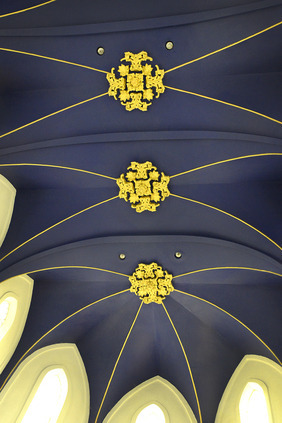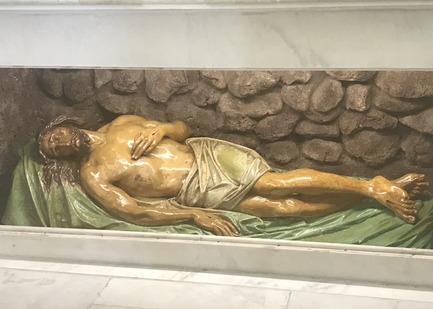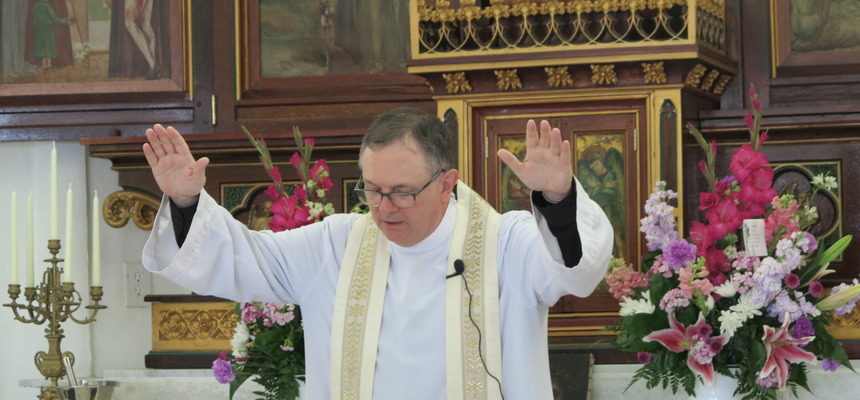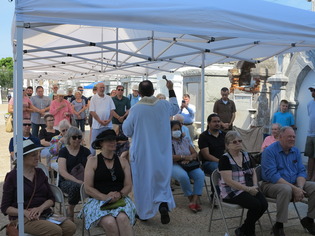
A platform that encourages healthy conversation, spiritual support, growth and fellowship

NOLACatholic Parenting Podcast
A natural progression of our weekly column in the Clarion Herald and blog

The best in Catholic news and inspiration - wherever you are!
Restored St. Roch Cemetery Chapel reopens as sacred space
-
Above: Father Patrick Williams, vicar general for the Archdiocese of New Orleans, led the May 14 rededication and blessing of St. Roch Cemetery Chapel, closed since 2005. A four-year overhaul of the chapel’s interior included the complete restoration of its badly damaged retable, visible in the background. (Photos by Beth Donze and Frank J. Methe of the Clarion Herald; and courtesy of New Orleans Catholic Cemeteries)
By BETH DONZE
Clarion HeraldThis morning, after more than a year of delays wrought by the COVID-19 pandemic, New Orleans Catholic Cemeteries unveiled its award-winning restoration of St. Roch Cemetery Chapel during a rededication and blessing ceremony attended by about 80 faithful.
Before blessing the chapel with holy water, prayer service leader Father Patrick Williams, vicar general for the Archdiocese of New Orleans, said sacred spaces like St. Roch Chapel, have important dual roles in the lives of the faithful. Not only do they provide “a window to the divine” that connects God’s earthbound children to “the transcendent,” they also bind together all those who pray and worship there – past, present and future.
“Whenever we gather, we are connected to them; our hearts and our prayers are lifted with them,” Father Williams said, referencing the prayer service’s reading from the First Letter of St. Peter, in which God’s children are called the “living stones” God uses to create his “spiritual temple” on earth.
“May this chapel be a comfort to the living and a sign of our hope for our unending life,” Father Williams prayed. “Make this chapel into a place of healing consolation for those who mourn, a place of prayer, and a reminder of the sure hope of the resurrection and God’s love for us.”
Still standing, 146 years later
Originally dedicated in 1876 in gratitude for St. Roch’s intercessory protection of New Orleanians during the era of yellow fever, the tiny, Gothic-style chapel has endured hurricanes, floods, termites and padlocked doors over its 146 years of existence.The chapel’s four-year overhaul, launched in 2017, included the complete restoration of its nave and 30-foot-high vaulted ceiling, the latter now painted midnight blue with gold accents.
The chapel’s brick walls, formerly bowing and in danger of collapse due to the use of moisture-trapping cement mortar, were re-pointed, and re-plastered with breathable, lime-based products.Restoration professionals also replaced termite-infested frames around the chapel’s 11 arched windows, installed all new electrical wiring and lighting, and reconfigured recesses in nave walls into 36 double-niches for the future in-chapel interment of cremated remains.
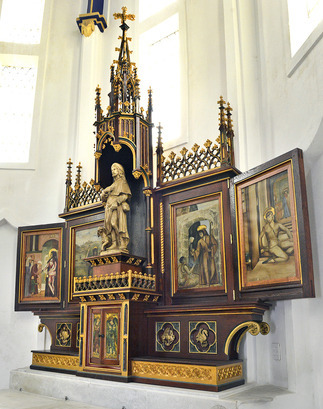 Retable brought back to life
Retable brought back to life
New and rehabilitated chapel furnishings include eight pews (salvaged from a decommissioned church in the northern U.S.), a 19th-century statue of St. Roch, a statue of Christ in the tomb, and a magnificently refurbished retable – a shelved unit above the altar featuring six painted scenes from the life of St. Roch. Ravaged by termites and six feet of water in the aftermath of Hurricane Katrina, the retable was painstakingly restored and pieced back together by third-generation master carpenter Juan Montoya, whose work included replicating features such as finials, floral medallions and spindlework.
During the restoration, a torn and faded portrait of Jesus wearing his crown of thorns was discovered inside the chapel's tabernacle and was sensitively restored for display at future Masses.St. Roch Chapel’s most famous interior feature was left largely untouched – the grotto-like room holding ex-votos – cast replicas of limbs, leg braces, crutches, children’s shoes and other tokens of gratitude for St. Roch’s healing intercession – survives as a historical freeze-frame of the prayers of past pilgrims.
Although the restoration focused almost entirely on the chapel’s interior, a new roof of standing seam copper now protects it from water intrusion, new steel beams stabilize its formerly termite-ridden attic, and its original bronze bell rings once again.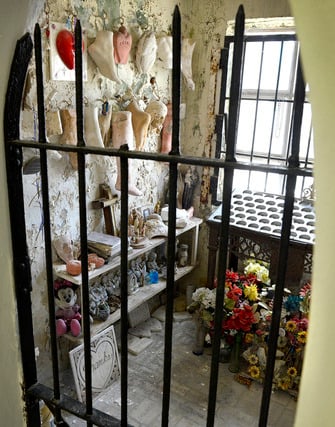
13th-century namesake, 19th-century needs
The chapel, which is also the National Shrine of St. Roch, is named for the Third Order Franciscan who devoted his life to caring for victims of the bubonic plague and was credited with miraculous cures. Born in 1295 in Montpellier, France, St. Roch is the patron saint of the sick, invalids, dogs and dog lovers.When New Orleans was plagued with wave after wave of yellow fever in the late 19th century, Father Peter Leonard Thevis, pastor of nearby Holy Trinity Church, asked his parishioners to pray to St. Roch for his intercession. In gratitude for a lull in disease outbreaks, Father Thevis’ flock erected the chapel in 1876 as a monument of gratitude.
Although subsequent generations of faithful packed the chapel for funerals, Masses and prayers for healing, use of the space began to dwindle as parishioner numbers at Holy Trinity Church declined (the church closed permanently in 2001) and neighborhood Catholics had access to the much larger Our Lady Star of the Sea Church, built in 1931.Already designated as a Local Historic Landmark in 2002, the chapel recently earned a 2022 “Award for Excellence in Historic Preservation” from the Louisiana Landmarks Society.
In addition to serving once again as the mortuary chapel for cemetery burials, Sherri Peppo, executive director of New Orleans Catholic Cemeteries, said the chapel will host a Healing Mass on the first Friday of each month at 10 a.m., beginning June 3. Society of Divine Word Father Emanuel Tanu, pastor of Our Lady Star of the Sea, will serve as principal celebrant of the Masses, which are open to all, especially to those in need of physical or spiritual healing. Seating capacity hovers between 24-32. The chapel is located in St. Roch Cemetery No. 1, 1725 St. Roch Ave. To inquire about burial options inside St. Roch Chapel, call (504) 596-3050; email [email protected]; or visit nolacatholiccemeteries.org.
[email protected]
